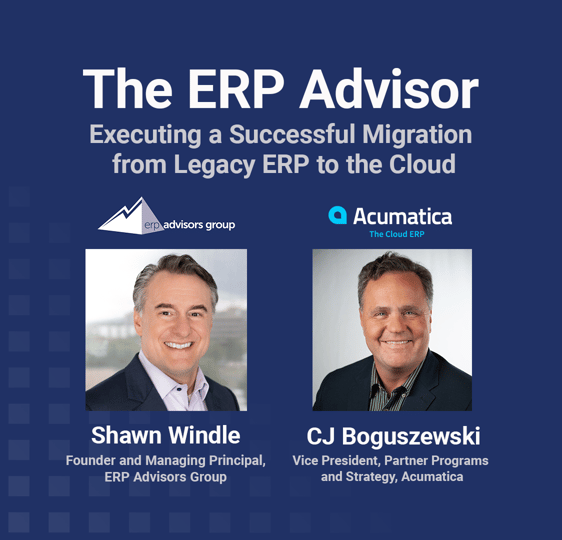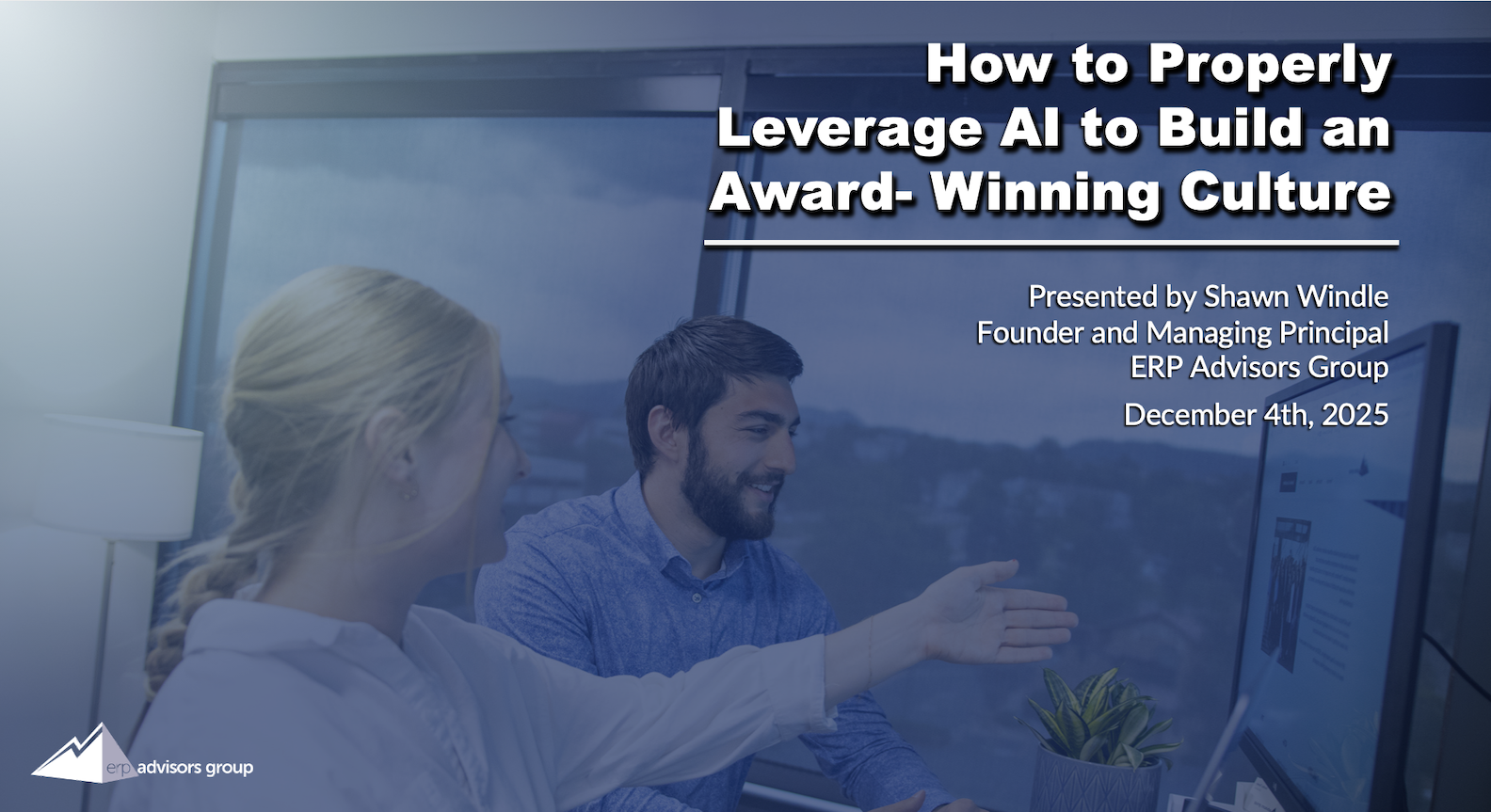
Executing a Successful Migration from Legacy ERP to the Cloud
Businesses are becoming increasingly more proactive in migrating from their legacy ERP software to the cloud, especially with increasing economic factors. While cloud ERP is the logical evolution for many of these organizations, a number of factors still make leaders hesitant to tackle a project in full force. It is vital for business leaders to study ERP projects and prepare to execute a migration from legacy ERP to the cloud successfully.
What are the Pitfalls of Staying on a Legacy Platform?
Legacy software can be detrimental to an organization and its ability to grow. There are a number of factors that signal the need to move from a legacy application into the cloud, but executives must be able to recognize the warning signs before it is too late, giving their team ample time to prepare for a migration.
The out-of-date nature of legacy systems leaves businesses vulnerable to the effects of a limited application. Legacy solutions rarely fall under vendor support policies; therefore, the application no longer receives vital updates and hotfixes. When a system is behind on upgrades, it introduces significant cybersecurity risks. It can also potentially limit the organization’s growth because basic processes are very manual processes which add costs and prevent staff from focusing as much time on value-add work. In general, businesses running on legacy software tend to rely on very specific individuals to maintain the system and ultimately maintain the “tribal knowledge” of how it all works! Along the human capital perspective, legacy software puts significant strain on an organization’s IT department because on-premises systems require maintaining hardware and software to support the ERP and resources with IT and database administration expertise.
Overall, it is important for businesses to recognize that if they are not proactive about supporting their legacy ERP system then a system breakdown, the loss of a key employee, sunset notification, or more could force your hand into an unplanned change. Taking the initiative to begin a migration prior to confronting this obstacle will allow your team to plan for success.
What Options do Users Have When It Comes to Leaving Legacy ERP Behind?
First and foremost, businesses must look objectively at their organization to determine if it is the right time to change. Sometimes, stumbling blocks present themselves that could be detrimental to any project even getting off the ground. In these situations, it is best to take a step back and make the decision that it is not time to undergo a digital transformation.
Upon the objective review of an organization, the team may realize it is the right time for an upgrade. Once a business decides to undergo an ERP migration to the cloud, they have multiple paths to a successful upgrade. The ultimate goal is to achieve implementation success in a way that ensures the business will not have to tackle a project of this magnitude again, especially if you are implementing a cloud ERP solution.
The approach for migrating from legacy ERP to the cloud can either be a “big bang” or more cautious with a waterfall model. The “big bang” approach involves implementing the system(s) all at once, going live with little to no user testing, and making adjustments once the system is operational. A “big bang” approach may be perfect for an organization quickly transforming to meet growing demands; however, this approach can be rushed and result in issues of improperly prepared end-users. It is vital to ensure that your team is prepared to effectively apply this approach and mitigate potentially disruptive operational changes brought on by migrating to cloud ERP.
The other extreme would be a waterfall approach, implementing a system piece by piece until reaching the ultimate ERP software go-live day. This approach may be slow and methodical, working with each department and its end-users to train and adapt to the new system. When evaluating this approach, understand that it may take more time and additional resources to complete but may set the stage for a more successful roll-out if key integrations will be restored in time for go-live.
Finally, there is a hybrid model, meant to implement the system in a timely manner with a more methodical approach. Because this approach can be carefully crafted to fit the organization’s needs, most experts would recommend this model when requirements allow for it. Ultimately, the executive team should carefully consult with industry experts prior to implementation.
Preparing for a Successful Migration to Cloud ERP
Customers who have grown accustomed to a legacy software application are often fraught with concerns preventing them from taking the plunge toward a new ERP or even the cloud version of their current product.
A number of factors contribute to a successful migration to the cloud, but the most vital and often overlooked piece is your data. Remember: the sooner you start your data migration, the better, and far too many project managers undervalue the role of data migration in implementation success.
It will come as no surprise, but customers are very concerned with data and its impact on the implementation. More specifically, they find themselves pondering what to bring and what to leave behind. The right ERP consultant can assist you with data cleansing, transformation, and validation which will pave the way for a successful go-live where the end users have the correct data for processing their transactions.
Developing a data plan is a vital first step because it will determine all your potential source systems, which one contains the ‘source of truth,” what data must be migrated from the legacy system into the new system, and which data can be left behind for historical reference. Like implementation itself, there are extremes to confronting data migration, one end being to bring all data from the legacy system into the cloud and the other being abandoning the data to start anew in the new system. The recommendation is almost always to find a middle ground where the business brings essential data and leaves behind unnecessary data that will only bog down the system. Relatively few companies would have the ability to type their customer and vendor names in freshly to a new system which would be necessary if you choose the “no data” approach. Besides, testing the system with your actual data helps to validate the configuration of the application at various points and can ensure fixes are made well ahead of go-live.
Project sponsors must sit down and determine the data needs of the business on a case-by-case basis because operations and ERP systems vary. The ERP system itself is extremely structured, intentionally, to organize operations and bring efficiency to the organization. Depending upon your operations, your data requirements will vary. To prevent data from derailing your ERP implementation, download EAG’s guide to data migration.
Another major concern is the overall complexity of ERP, especially for customers leaving behind spreadsheet-based operations. Customers may look at the sophistication offered by a shiny, new cloud ERP and feel intimidated by the increase in functionality and changing processes. While this may be a point of contention, the business world is rapidly evolving, with technology increasing in sophistication every day, so an organization's ERP must evolve with the market. The development of a strong business case for new ERP and effective training plans for end users will mitigate many of these concerns.
In the end, leadership must recognize the application that will work best for their organization, whether that be drastic change or a model that follows the layout of their legacy system. Whether it is an all-in-one ERP or a composable system with a diverse ecosystem, the project team must select the solution that will fit and allow the business to grow. Regardless of the concerns, careful planning and the right support will help to ensure the success of your project and the selection of the right solution and deployment.
What is the Implementation Partner’s Role in Ensuring the Success of a Project?
To be frank, your project will fail without a good implementation partner; unfortunately, most project managers overlook this vital role in ensuring the success of their digital transformation. From the perspective of an industry expert, it is best practice to select your implementation partner while you are selecting your software.
An effective implementation partner, especially when migrating to the cloud, will have a winning combination of cloud experience and a “cloud” mentality because, for those individuals, the most important thing their client can do is go live. When selecting an implementation partner, do your due diligence to encourage project success, and seal the deal by checking the partner and vendor’s references.
Conclusion
Selecting the right ERP built on a flexible and extensible platform will ensure the future success of your business, despite the disruptive nature of an ERP upgrade. The strong foundation that cloud ERP brings to an organization allows the system to scale up or down in accordance with operational needs, making it an ideal solution for many businesses; however, your organization must properly prepare to execute a successful migration from legacy ERP to the cloud. To kickstart your ERP project, contact an expert ERP consultant today.





